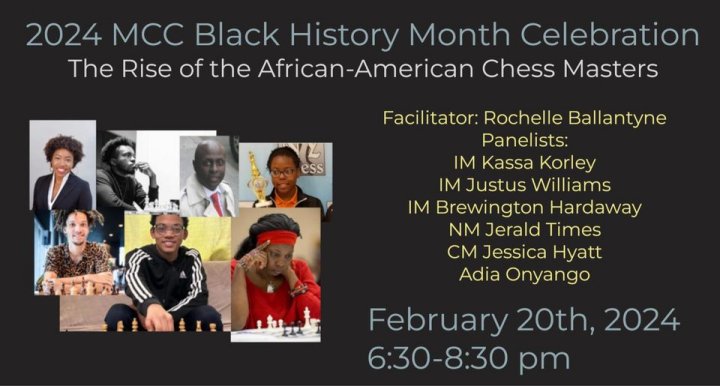.jpeg)

.jpeg)
Text: Jerald Times
A game that once traveled on the Silk Road in the Middle Ages finds itself in Black communities' barbershops, parks, schools, and local clubs. In recent years, narratives of Black players have exploded on the chess scene. Prodigies such as Tani Adewumi and Brewington Hardaway have made headlines for becoming chess masters by the age of ten.

Tani Adewumi | Source: Twitter/X-Account Tani Adewumi

Brewington Hardaway, who became an IM at the age of 14 | Photo: Ikuko Hardaway | Source: The Chess Drum
Talents like James Black, Justus Williams, and Joshua Colas were awarded scholarships to play for intercollegiate champ Webster University. Esports signed names like Frank Johnson and James Canty to promote the game.
 James Canty at the Maia Festival in Portugal | Photo: Maia Chess Festival
James Canty at the Maia Festival in Portugal | Photo: Maia Chess Festival
At least two Black women have beaten Grandmasters; Sabrina Chevannes defeated Alexander Shabalov in 2015, and Jessica Hyatt bested Michael Rohde in 2022. Yet another Black woman, Tris Ann Richards, became the President of the St Lucia Chess Federation.

ChessBase author Sabrina Chevannes

Jessica Hyatt | Photo Source: Black Heroes Foundation

Tris Ann Richards | X/Twitter Account of Tris Ann Richards
To understand the underpinnings of this contemporary success, we would have to travel back over thirty years when a middle school team from Harlem called the ‘Raging Rooks’ won the national championship in 1991. This team was sponsored by ACF (American Chess Foundation), which eventually became (CIS) Chess-in-the-Schools. It was coached by Maurice Ashley, who later became a grandmaster and one of the top commentators in the game. Chess, before the Raging Rooks, was seen mainly as a White sport that was played primarily in private schools, but an inner city team from Harlem winning the national championship made the front page of The New York Times.

The Raging Rooks
An early member of the American Chess Foundation was Bruce Pandolfini. Bruce suggested the best way to promote chess was to create an audience for the game by instructing school children. Pandolfini states, "I wanted to reach kids with no access to enrichment programs, who could not afford coaching and were not even assured of having lunch - kids whose gains from the discipline of chess would most benefit society. I strongly sensed Title 1 was the way to go, and that’s where we went." Under Bruce’s suggestion, ACF would shift its focus to Title 1 schools, and millions of dollars of resources started pouring into inner-city schools.
Besides focusing on inner-city schools, ACF published the Margulies Report under its new name, Chess-in-the-Schools 1993, which showed the positive correlation between chess and reading scores. Stuart Margulies was a chess master who received a Ph.D. from Columbia University, and the gravity of this report would help the general public understand that chess was not just about competing in an intellectual sport, but the game was academically rewarding. The report states: "The teachers in District Nine believe their chess-playing students develop enhanced ego strength as they increase their chess competency. They argue that students who feel confident and good about themselves naturally learn to read better."
With the Raging Rooks' success and the Margulies Report's revelations, a movement was growing. New York donors Fanuille Adams and Lewis Cullman gave millions of dollars to CIS; Billionaires Daniel Rose and Stanley Druckenmiller also gave considerable resources to communities of color to develop chess programs. This was the boost that Black chess needed.
With incoming resources coming into Title 1 schools, the coaches in New York City set their eyes on national championships, which raised the competitive standards within scholastic chess and inner-city youth. I.S. 318 in Brooklyn, CES 70 in the Bronx, and the Mott Hall school in Harlem were all Title 1 schools that won national titles in the nineties.
To understand the broader impact of the New York Youth Movement, I.S. 318 was the subject of the documentary "Brooklyn Castle," CES 70 quest for the national title became a film called "Knights of the South Bronx." Of course, the youth movement was not exclusive to New York. Detroit, Chicago, and many cities in Texas have also poured in capital to develop programs in Title 1 schools.
While the youth movement was burgeoning, many African American masters sought FIDE titles but did not have the infrastructure support of the Title 1 schools. The question that arose was, why are there so few Black Grandmasters? To understand this divide and address the limited number of Black Grandmasters, Daaim Shabazz of The Chess Drum says, "I can say that wherever there is social bonding around chess in the Black community, you see widespread successes. However, going for titles takes another level of commitment. For the Black chess player, opportunity costs remain prohibitive. You have to decide how to spend your time and money, and chess does not offer an adequate return on investment for time and resources. It becomes critical if you are struggling economically and can't afford $1000-1500 in expenses to travel to a major tournament offering norms."
With financial support from Daniel Rose, Maurice Ashley made Grandmaster in 1999 and, along with his scintillating style as a commentator, was a rising star in the chess world. Amongst his many accomplishments, Maurice gave visibility to Black chess. In contrast to previous depictions of Black chess players, Maurice was no park hustler but a bona fide Grandmaster who could speak eloquently on the game.

Maurice Ashley in the ChessBase studio
Partly inspired by Maurice’s achievements, other talented chess players in the community wanted FIDE titles, but many complained they had limited opportunities to achieve norms. In 2001, Maurice teamed up with international arbiter Jerry Bibuld and Wall Street mogul and African-American chess master Jones Murphy to create a tournament of all-Black chess masters called the Wilbert Paige Memorial. Wilbert Paige was a chess master from Philadelphia who died in his thirties. To celebrate his legacy, an international master norm tournament was organized, and Bibuld invited competitors from six countries, including three African countries.
The tournament was held at the historic Hotel Theresa in Harlem. WP Memorial was an all-star cast of Black talent, including future Grandmasters Kenny Solomon from South Africa and Amon Simutowe from Zambia.

Amon Simutowe | Photo: Wikipedia
Another invitee, South African Watu Kobese, who speaks eleven languages, had stunned the chess world a few months earlier with his victory over Super Grandmaster Peter Leko, rated number seven on the FIDE rating list. Other notables competing were three members of the famed Blackbear School, a chess club that produced some of the strongest Black masters in the country. As the WP memorial was a spectator event, two players the crowd would have liked to see were five-time US Arm Forces Champion Emory Tate, who was known for his dynamic attacking style, and the tactical wizard Robert Gwaze from Zimbabwe, who, one year later would win the Gold Medal in the 2002 Bled Chess Olympiads on board one over Garry Kasparov. Ultimately, Stephen Muhammad would win the WP Memorial and a few years later become the first naturalized African-American Citizen to achieve the international master title.
-chess-drum.jpg)
Stephen Muhammad | Photo: Daim Shabazz | Source: The Chess Drum
Today, the aspirations of the WP Memorial have materialized as there are Black Grandmasters in various parts of the international community; still, no Black player born in the United States has achieved the Grandmaster title. Kasa Korley, Justus Williams, and Brewington Hardaway may be the first.
There is also a push to create the first African-American female US Chess-rated master. As women are a minority in chess, Black women are a minority within that minority. US Chess Tournament Director Tiffany Harris believes "Black women playing chess often face challenges related to representation, stereotypes, and access to resources." Her remedy is to "Establish mentorship programs that can connect aspiring Black women players. Also, enable access to quality chess training materials, scholarships, and online programs."
A frontrunner in the race for the first African American female to reach US Chess master is Jessica Hyatt, who bested two GMs, including Abhimanyu Mishra, in an exhibition game. Other African American women seeking the title are Brooklyn Castle star Rochelle Ballantyne and chess expert Adia Onyango, AKA the Traveling Chess Player. An African American woman achieving the US Chess Master’s title will be the next milestone in chess and also symbolic of the growing demographics in the game.

Rochelle Ballantyne | Source: YouTube, Stanford 125, Rochelle Ballantyne

Adia Onyango | Photo: Daim Shabazz | Source: The Chess Drum
In the millennial, there was a burgeoning of Black talent achieving the grandmaster title but had received limited visibility. Cuba led the way with several Black grandmasters, including three-time Cuban champion Isan Reynaldo Ortiz Suárez and five-minute speed specialist Orelvis Perez Mitjans. Sweden produced its first Black GM in Pontus Carlsson in 2007, while the Dominican Republic was awarded its first GM in 2008 with Ramon Mateo. Finally, sub-Saharan Africa had its first GM title in Amon Simutowe from Zambia in 2009. Black chess is now an intercontinental phenomenon.

Ramon Mateo | Photo: Dominique Primel
As we reflect upon recent events, we can say the decision to broaden the chess audience significantly impacted Black chess players. The New York City scholastic chess scene was a battleground of talented players and the meeting ground for disparate groups. Chess's superpower is its social network; chess has the power to bring people together. Google engines list the number of people that play chess worldwide as over 600 million. Within these global numbers is an emerging group of Black players.

Jerald Times (left) coaching a young talent
Please note: On Tuesday, Feb 20th, 6:30pm, The Marshall Chess Club will host a panel to celebrate the Black Month History.

Holistic programs: Combining music, storytelling, chess and tai-chi
| Advertising |